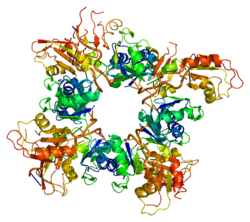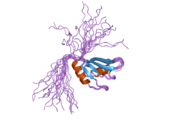PABPC1
| View/Edit Human | View/Edit Mouse |
Polyadenylate-binding protein 1 is a protein that in humans is encoded by the PABPC1 gene.[3]
Function
The poly(A)-binding protein (PAB or PABP), which is found complexed to the 3' poly(A) tail of eukaryotic mRNA, is required for poly(A) shortening and translation initiation. In humans, the PABPs comprise a small nuclear isoform and a conserved gene family that displays at least 3 functional proteins: PABP1 (PABPC1), inducible PABP (iPABP, or PABPC4; MIM 603407), and PABP3 (PABPC3; MIM 604680). In addition, there are at least 4 pseudogenes, PABPCP1 to PABPCP4.[supplied by OMIM][4]
Interactions
PABPC1 has been shown to interact with:
References
- ↑ "Human PubMed Reference:".
- ↑ "Mouse PubMed Reference:".
- ↑ Grange T, de Sa CM, Oddos J, Pictet R (Aug 1987). "Human mRNA polyadenylate binding protein: evolutionary conservation of a nucleic acid binding motif". Nucleic Acids Res. 15 (12): 4771–87. doi:10.1093/nar/15.12.4771. PMC 305917
 . PMID 2885805.
. PMID 2885805. - ↑ "Entrez Gene: PABPC1 poly(A) binding protein, cytoplasmic 1".
- ↑ Koloteva-Levine N, Pinchasi D, Pereman I, Zur A, Brandeis M, Elroy-Stein O (May 2004). "The Apc5 subunit of the anaphase-promoting complex/cyclosome interacts with poly(A) binding protein and represses internal ribosome entry site-mediated translation". Mol. Cell. Biol. 24 (9): 3577–87. doi:10.1128/mcb.24.9.3577-3587.2004. PMC 387753
 . PMID 15082755.
. PMID 15082755. - ↑ Funakoshi Y, Doi Y, Hosoda N, Uchida N, Osawa M, Shimada I, Tsujimoto M, Suzuki T, Katada T, Hoshino S (Dec 2007). "Mechanism of mRNA deadenylation: evidence for a molecular interplay between translation termination factor eRF3 and mRNA deadenylases". Genes Dev. 21 (23): 3135–48. doi:10.1101/gad.1597707. PMC 2081979
 . PMID 18056425.
. PMID 18056425. - 1 2 Imataka H, Gradi A, Sonenberg N (Dec 1998). "A newly identified N-terminal amino acid sequence of human eIF4G binds poly(A)-binding protein and functions in poly(A)-dependent translation". EMBO J. 17 (24): 7480–9. doi:10.1093/emboj/17.24.7480. PMC 1171091
 . PMID 9857202.
. PMID 9857202. - ↑ Hoshino S, Imai M, Kobayashi T, Uchida N, Katada T (Jun 1999). "The eukaryotic polypeptide chain releasing factor (eRF3/GSPT) carrying the translation termination signal to the 3'-Poly(A) tail of mRNA. Direct association of erf3/GSPT with polyadenylate-binding protein". J. Biol. Chem. 274 (24): 16677–80. doi:10.1074/jbc.274.24.16677. PMID 10358005.
- ↑ Roy G, De Crescenzo G, Khaleghpour K, Kahvejian A, O'Connor-McCourt M, Sonenberg N (Jun 2002). "Paip1 interacts with poly(A) binding protein through two independent binding motifs". Mol. Cell. Biol. 22 (11): 3769–82. doi:10.1128/mcb.22.11.3769-3782.2002. PMC 133836
 . PMID 11997512.
. PMID 11997512. - ↑ Craig AW, Haghighat A, Yu AT, Sonenberg N (Apr 1998). "Interaction of polyadenylate-binding protein with the eIF4G homologue PAIP enhances translation". Nature. 392 (6675): 520–3. doi:10.1038/33198. PMID 9548260.
- ↑ Khaleghpour K, Kahvejian A, De Crescenzo G, Roy G, Svitkin YV, Imataka H, O'Connor-McCourt M, Sonenberg N (Aug 2001). "Dual interactions of the translational repressor Paip2 with poly(A) binding protein". Mol. Cell. Biol. 21 (15): 5200–13. doi:10.1128/MCB.21.15.5200-5213.2001. PMC 87244
 . PMID 11438674.
. PMID 11438674.
Further reading
- Görlach M, Burd CG, Dreyfuss G (1994). "The mRNA poly(A)-binding protein: localization, abundance, and RNA-binding specificity". Exp. Cell Res. 211 (2): 400–7. doi:10.1006/excr.1994.1104. PMID 7908267.
- Campbell LH, Borg KT, Haines JK, Moon RT, Schoenberg DR, Arrigo SJ (1994). "Human immunodeficiency virus type 1 Rev is required in vivo for binding of poly(A)-binding protein to Rev-dependent RNAs". J. Virol. 68 (9): 5433–8. PMC 236943
 . PMID 8057425.
. PMID 8057425. - Huang Y, Carmichael GG (1996). "Role of polyadenylation in nucleocytoplasmic transport of mRNA". Mol. Cell. Biol. 16 (4): 1534–42. PMC 231138
 . PMID 8657127.
. PMID 8657127. - Craig AW, Haghighat A, Yu AT, Sonenberg N (1998). "Interaction of polyadenylate-binding protein with the eIF4G homologue PAIP enhances translation". Nature. 392 (6675): 520–3. doi:10.1038/33198. PMID 9548260.
- Afonina E, Stauber R, Pavlakis GN (1998). "The human poly(A)-binding protein 1 shuttles between the nucleus and the cytoplasm". J. Biol. Chem. 273 (21): 13015–21. doi:10.1074/jbc.273.21.13015. PMID 9582337.
- Imataka H, Gradi A, Sonenberg N (1999). "A newly identified N-terminal amino acid sequence of human eIF4G binds poly(A)-binding protein and functions in poly(A)-dependent translation". EMBO J. 17 (24): 7480–9. doi:10.1093/emboj/17.24.7480. PMC 1171091
 . PMID 9857202.
. PMID 9857202. - Hornstein E, Git A, Braunstein I, Avni D, Meyuhas O (1999). "The expression of poly(A)-binding protein gene is translationally regulated in a growth-dependent fashion through a 5'-terminal oligopyrimidine tract motif". J. Biol. Chem. 274 (3): 1708–14. doi:10.1074/jbc.274.3.1708. PMID 9880551.
- Laroia G, Cuesta R, Brewer G, Schneider RJ (1999). "Control of mRNA decay by heat shock-ubiquitin-proteasome pathway". Science. 284 (5413): 499–502. doi:10.1126/science.284.5413.499. PMID 10205060.
- Hoshino S, Imai M, Kobayashi T, Uchida N, Katada T (1999). "The eukaryotic polypeptide chain releasing factor (eRF3/GSPT) carrying the translation termination signal to the 3'-Poly(A) tail of mRNA. Direct association of erf3/GSPT with polyadenylate-binding protein". J. Biol. Chem. 274 (24): 16677–80. doi:10.1074/jbc.274.24.16677. PMID 10358005.
- Deo RC, Bonanno JB, Sonenberg N, Burley SK (1999). "Recognition of polyadenylate RNA by the poly(A)-binding protein". Cell. 98 (6): 835–45. doi:10.1016/S0092-8674(00)81517-2. PMID 10499800.
- Féral C, Mattéi MG, Pawlak A, Guellaën G (1999). "Chromosomal localization of three human poly(A)-binding protein genes and four related pseudogenes". Hum. Genet. 105 (4): 347–53. doi:10.1007/s004390051113. PMC 1865476
 . PMID 10543404.
. PMID 10543404. - Grosset C, Chen CY, Xu N, Sonenberg N, Jacquemin-Sablon H, Shyu AB (2000). "A mechanism for translationally coupled mRNA turnover: interaction between the poly(A) tail and a c-fos RNA coding determinant via a protein complex". Cell. 103 (1): 29–40. doi:10.1016/S0092-8674(00)00102-1. PMID 11051545.
- Khaleghpour K, Svitkin YV, Craig AW, DeMaria CT, Deo RC, Burley SK, Sonenberg N (2001). "Translational repression by a novel partner of human poly(A) binding protein, Paip2". Mol. Cell. 7 (1): 205–16. doi:10.1016/S1097-2765(01)00168-X. PMID 11172725.
- Bushell M, Wood W, Carpenter G, Pain VM, Morley SJ, Clemens MJ (2001). "Disruption of the interaction of mammalian protein synthesis eukaryotic initiation factor 4B with the poly(A)-binding protein by caspase- and viral protease-mediated cleavages". J. Biol. Chem. 276 (26): 23922–8. doi:10.1074/jbc.M100384200. PMID 11274152.
- Féral C, Guellaën G, Pawlak A (2002). "Human testis expresses a specific poly(A)-binding protein". Nucleic Acids Res. 29 (9): 1872–83. doi:10.1093/nar/29.9.1872. PMC 37253
 . PMID 11328870.
. PMID 11328870. - Khaleghpour K, Kahvejian A, De Crescenzo G, Roy G, Svitkin YV, Imataka H, O'Connor-McCourt M, Sonenberg N (2001). "Dual Interactions of the Translational Repressor Paip2 with Poly(A) Binding Protein". Mol. Cell. Biol. 21 (15): 5200–13. doi:10.1128/MCB.21.15.5200-5213.2001. PMC 87244
 . PMID 11438674.
. PMID 11438674. - Woods AJ, Roberts MS, Choudhary J, Barry ST, Mazaki Y, Sabe H, Morley SJ, Critchley DR, Norman JC (2002). "Paxillin associates with poly(A)-binding protein 1 at the dense endoplasmic reticulum and the leading edge of migrating cells". J. Biol. Chem. 277 (8): 6428–37. doi:10.1074/jbc.M109446200. PMID 11704675.
- Lee J, Bedford MT (2002). "PABP1 identified as an arginine methyltransferase substrate using high-density protein arrays". EMBO Rep. 3 (3): 268–73. doi:10.1093/embo-reports/kvf052. PMC 1084016
 . PMID 11850402.
. PMID 11850402. - Jurica MS, Licklider LJ, Gygi SR, Grigorieff N, Moore MJ (2002). "Purification and characterization of native spliceosomes suitable for three-dimensional structural analysis". RNA. 8 (4): 426–39. doi:10.1017/S1355838202021088. PMC 1370266
 . PMID 11991638.
. PMID 11991638.
This article is issued from Wikipedia - version of the 11/2/2016. The text is available under the Creative Commons Attribution/Share Alike but additional terms may apply for the media files.





